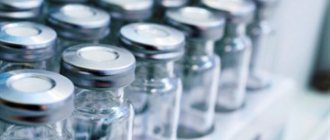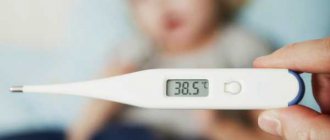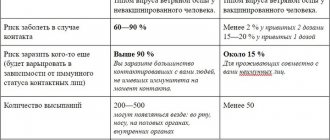Causes of pain
Vaccines introduce inactivated pathogens into the human body. They “irritate” the immune system, provoking it to fight the infectious disease. Your own immune cells begin to destroy uninvited strangers.
Because of this, a reaction occurs: pain, redness, swelling where the drug was injected. This response is not a complication; it goes away on its own after a few days.
Duration of pain
The injection site may be sore for 2–3 days .
During this period of time, severe pain should not appear; this discomfort can be easily tolerated. Afterwards, the discomfort passes, the swelling subsides, and the redness disappears.
If after 3 days the pain remains, an abscess has formed at the injection site, or a fever has developed, you should consult your doctor.
Possible locations
The DTP vaccine is administered into the thigh for children and under the shoulder blade for adults.
Before vaccination, the doctor examines the patient and issues permission to carry out the procedure.

After administration of the drug, pain may appear under the shoulder blade. This is not always the puncture site.
Pain sensations spread to the shoulder, forearm, and the shoulder blade may ache.
Sometimes the injection turns yellow, this indicates that the capillary was damaged by the syringe and a small amount of blood got under the skin.
Pain under the shoulder blade
In 90% of cases, as soon as the inactivated diphtheria bacillus is inserted under the shoulder blade, patients experience pain and discomfort. This is a normal reaction that disappears a day after the procedure.
As soon as the immune cells begin to fight the weakened pathogens, soreness appears in the shoulder blade if the vaccine is placed under it.
Unpleasant sensations can spread to the entire back area.
In an adult, the pain should not be severe, since similar vaccines were administered in childhood, and the immune system recognizes them faster than in a child.
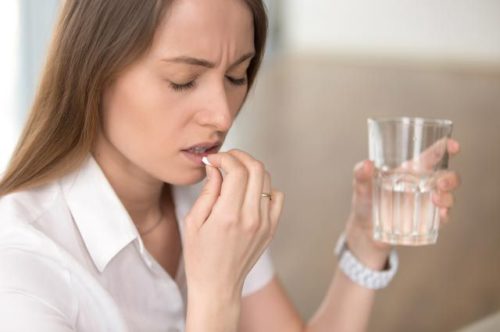
To ease the pain, you can take combined painkillers and antipyretics - Paracetamol or Ibuprofen.
Backache
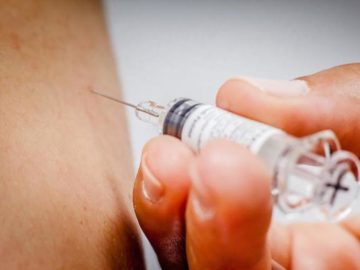
This symptom is considered a normal reaction and is not considered a complication. Within 2–3 days, antibodies are produced to the injected weakened diphtheria bacillus.
After a few days the symptom goes away on its own. If the pain is nagging in nature, radiates to the arm, and is not relieved by analgesics, in adults a pinched nerve during the procedure is suspected.
Perhaps the nerve endings were damaged during the needle insertion process. Pathology requires a thorough examination.
Arm pain
This symptom does not appear immediately, but several days after vaccination.
In this case, the following symptoms are observed:
- mild pain at the vaccination site;
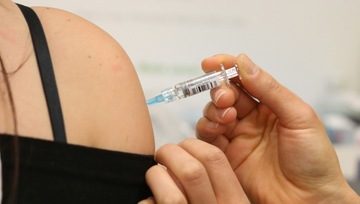
increased pain, spreading to the entire limb;- inflammation appears in the injection area, redness, and the skin becomes hot;
- swelling (lump) exceeds 5 cm in diameter;
- impaired sensitivity in the limb, the arm hurts so much that it is difficult for it to move.
These symptoms are classified as post-vaccination symptoms. They appear in patients with particular sensitivity to the components of the vaccine.
Such reactions do not require medical intervention if their intensity decreases after 2–3 days. Otherwise, you need to see a doctor.
Gives to the leg
The complex DTP vaccine, which is also effective against diphtheria, is administered not only under the shoulder blade, but also into the thigh. This method ensures that the vaccine gets into the muscle and not under the skin, which is strictly prohibited. Mostly children are given an injection in the thigh.

When your leg hurts after vaccination, this is a sure sign that your immune system is working well.
The symptom may be accompanied by other reactions: redness, swelling, fever, vomiting, diarrhea, drowsiness. These signs are considered normal.
An acute allergic reaction, urticaria, which is accompanied by pain in the leg and severe swelling are side effects. In this case, taking antihistamines is indicated.
The child’s temperature begins to drop with a slight increase in readings, without waiting for it to rise sharply.
If the pain is severe
For severe pain, take painkillers: Paracetamol and Ibuprofen. They also reduce the temperature. If there is no chill, take analgesics.
For local anesthesia, you can apply ointments: Ichthyol, Vishnevsky. They relieve pain and accelerate the healing of inflamed tissue.
Pain should subside within 72 hours. Pain after vaccination on the fourth day is not normal. Doctors should warn about possible side effects and methods to combat them before administering the vaccine.
After DPT vaccination there is thickening and redness: what to do, do you need to see a doctor?
ACDC is a comprehensive childhood vaccination program to prevent fatal diseases such as whooping cough, tetanus, and diphtheria. Polio vaccination is often carried out simultaneously with DPT.
Vaccination against these diseases is necessary since there is no mass immunity in the population, as is the case with smallpox. Vaccinations are not always easily tolerated by children. Each child's reaction to the vaccine is individual and may be accompanied by redness and swelling at the injection site.
However, if the skin is red and thickened after ACDS, there is no reason to panic.
Is a lump at the DPT vaccination site dangerous?
A red spot after vaccination is a typical reaction of the body to the vaccine. The filling appears 2-3 days after vaccination. The vaccination spot swells and turns red.
The general body temperature may rise to 37°C and the child may feel weak and dizzy. It is common to experience an overreaction with the Pentaxim vaccine. Symptoms disappear after a few days.
This reaction is normal and should not cause concern to parents.
Sometimes complications arise:
- the size of the edema exceeds 1 cm;
- thickening in the form of a tumor is observed;
- body temperature rises significantly;
- the injection site is painful;
- runny nose and cough
If these symptoms do not disappear within 3 days, or the illness lasts longer, the child should be shown to a pediatrician.
- abscess;
- allergic reactions;
- persistent fever;
- diarrhea;
- the child cries constantly;
- lethargy and loss of appetite.
If such symptoms occur, you should consult a doctor immediately. Before vaccination, you must consult with a specialist, listen to his answers and instructions, and strictly follow the recommendations.
The reaction to DPT vaccination can be very severe. This usually occurs when contraindications are not taken into account or when hygiene rules are not followed after surgery. If the following symptoms appear, you should call an ambulance:
WO: How long does it take to respond to ACDS?
- redness in an area greater than 8 cm;
- touching the injection site causes severe pain;
- temperature rise to 39.0-40.0°C;
- severe allergies;
- convulsions.
Causes of redness and thickening at the injection site
Minor redness and swelling caused by DCA is not dangerous and is a typical reaction to the vaccine and will go away on its own. If after vaccination a tumor forms on the thigh or buttocks and does not subside for a long time, this can be considered a local complication.
Reasons for this phenomenon:
- Infiltration. The vaccine accumulates at the injection site and it takes some time for the accumulated material to be absorbed and absorbed.
- Penetration of a needle into adipose tissue. If the vaccination technique is correct, the needle should penetrate the child’s muscles. There are cases when the needle penetrates into the subcutaneous tissue, where the suction force slows down and a tumor forms.
- The reaction of lymphocytes to the penetration of foreign bodies.
- Infection in the wound and inflammation, often with accumulation of pus.
READING: How to learn to inject children in the butt?
Lump with pus
Symptoms that require immediate medical attention:
- Redness is strong, pus accumulates in the infiltration;
- Thinning of the epidermal wall at the injection site, causing spontaneous opening of the epidermis;
- the skin over the seal is very hot;
- the child's leg is swollen;
- a sharp increase in body temperature;
- severe pain, the child is crying.
These symptoms indicate imminent inflammation after vaccination. Only a surgeon can accurately diagnose this disease. An abscess is an inflamed, dense structure that, when softened, releases pus.
The cold form typical of BCG effects is not typical of ACDS. Pus can break out both externally and on the skin and infect muscle tissue. This is dangerous for the child.
In this case, the doctor may prescribe antibiotic therapy or surgery.
Treatment
What to do if the injection site on your leg is swollen?
To make your child feel better, you need to do the following:
- stop taking vitamin D if your child took it before vaccination;
- give the child more to drink, food should be moderate;
- stop walking on the first day after vaccination;
- exclude contact of the injection site with water, do not bathe the child for several days;
- can be applied to the seal using an iodine grid;
- do a gentle massage, without pressing on the seal, moving in a circle;
- cream the problem area with special ointments, which were previously discussed with the doctor;
- Monitor the baby's condition carefully.
WHAT children under one year of age are vaccinated prophylactically?
Ointments for compaction and redness
Medicines should be used after consultation with a pediatrician and determining the cause of the nodular pattern. Your child's condition will improve significantly if you apply medicinal ointment to the surrounding area. The pharmaceutical industry offers many special ointments for removing a nodule after ACDS vaccination:
CAN ALSO BE READ:
- Troxevasin - reduces redness, promotes the absorption of pus, is used when a needle enters adipose tissue;
- Aescusan - improves blood circulation, accelerates vaccine absorption and reduces thickening;
- Fenistil - eliminates itching and pain, the seal on the leg is absorbed;
- Heparin ointment - relieves pain and thickening, Vitaon balm has the same effect.
These medications are available to the public, but they should not be used alone without consulting a specialist. Only a doctor can answer how many drugs can be used once for a child and why this particular drug should be chosen in a particular situation.
Other drugs
In case of complications or if the tumor does not disappear for a long time after vaccination, the doctor may prescribe additional treatment:
- for allergic reactions - antihistamines Fenistil, Zodak, Zirtec;
- for inflammatory processes - antimicrobial drugs;
- for high temperatures - antipyretic Nurofen or paracetamol.
Is it possible to use folk remedies?
Traditional medicine has many ways to help a baby after vaccination. It should be noted that the use of unconventional remedies without consultation with a pediatrician is not recommended, since clumsy manipulations can lead to significant damage to the child’s body, weakened as a result of vaccination.
Parents must know for sure whether the child is allergic to a drug that will be used for therapeutic purposes. For example, if your child is allergic to honey, using honey to dissolve the lump can have serious consequences.
The safest traditional therapies:
- Cabbage leaf compress. In several places, thoroughly wash or cut the cabbage leaves, pour boiling water over them, apply to the affected area and cover with parchment. Leave the compress on for 3 hours. The procedure can be performed during the day while sleeping. This method is considered effective in reducing redness and swelling.
- sodalocia. One tablespoon of drinking water is divided into 100 g of boiled water. Soak a gauze rag in the baking soda solution and apply it to the pad. The lump will shrink. Mix chicken egg yolk
- , a small amount of honey, flour and a tablespoon of butter. Apply the resulting dough to thicken.
- Briolin with aloe juice. It's better to do this in the morning. Aloe compress absorbs unevenness well and has an anti-inflammatory effect.
Pain and redness

It may not be strong and goes away the next day. In people suffering from allergies, the redness can only intensify and take the form of hives.
Before vaccination, patients with allergies must notify their doctor of their diagnosis . In this case, antihistamines are prescribed before and after vaccination to reduce the allergic reaction to a minimum.
How to relieve pain
Some patients refuse to take pain medications after vaccination. You can replace medications with local anesthetics or folk remedies.
To reduce swelling, relieve redness and pain, it is recommended to apply a cabbage leaf to the injection site.
Pain relieving compress:
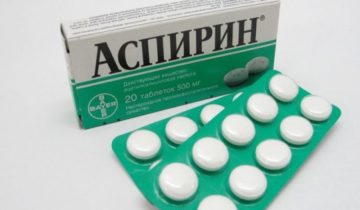
Crush 1 aspirin tablet, mix with 2 tbsp. l. alcohol- Lubricate the area where the vaccine is introduced with warm vegetable oil.
- Spread the mixture of aspirin and alcohol evenly over a piece of gauze folded in several layers.
- Apply the fabric to the damaged skin and secure with adhesive tape.
It is better to do the compress at night. During the day, the procedure is repeated, applying gauze soaked in the medicinal mixture for 3 hours. After 4 sessions, the pain goes away, the redness and compaction disappear.
Complications
Any vaccination has side effects that lead to complications. Such reactions occur rarely, but you need to be prepared for them. They are divided into local and general.
A local reaction is the appearance of a lump, lump, or redness at the injection site, the area of which increases to 8 cm in diameter.
Acute immune reactions:
- Rash, redness, and hives can appear not only at the injection site of the serum, but also in any part of the body. An allergic reaction usually occurs 30 minutes after the injection, in some cases – after 2-3. Antihistamines will help relieve discomfort.
- Rapid heartbeat or slow pulse. This reaction is temporary, but requires consultation with a doctor.
- Severe swelling that extends beyond the injection area spreads to the neck, arm and back.

Cramps and pain in joints and muscles. In some cases, inflammation of the joint capsule is observed.- Impaired consciousness and coordination of movements, darkening of the eyes, fainting, nausea, dizziness, febrile convulsions.
- Loss of appetite. This reaction lasts several days and goes away on its own; no medical attention is needed.
- Difficulty breathing, severe, cough, shortness of breath.
- Convulsive syndrome, fever up to +38 °C and above.
A rare complication is angioedema, anaphylactic shock. This is an acute reaction of the body, dangerous to human life. Occurs within the first 30 minutes after the vaccine is administered.
This is why doctors recommend staying in the hospital for half an hour after vaccination.
To avoid unwanted reactions of the body to the introduction of the vaccine, follow the general rules. The specialist warns the patient about them 1-2 days before visiting the clinic.

Vaccination rules:
- complete absence of symptoms of viral, infectious or chronic diseases;
- body temperature should be normal;
- Vaccinations are not given to persons with disorders of the central nervous system or immunodeficiency.
Patients suffering from allergies are vaccinated with a vaccine that does not contain the pertussis component.
Why does your arm hurt after getting vaccinated against coronavirus?
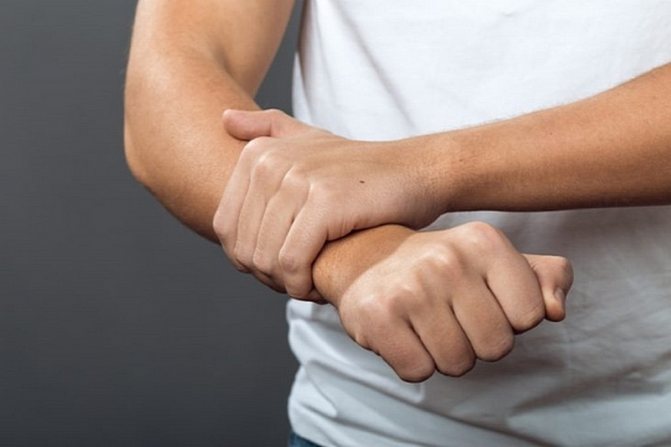
Usually, after an injection, local reactions to the injected agent appear - redness, swelling, pain. This is normal for any vaccine, as it only works locally at first. Pain in the arm after vaccination against coronavirus can be explained by several factors:
- The administered drug causes a strong reaction of the immune system, which causes a local inflammatory process to begin, which leads to unpleasant sensations in the limb.
- A person experiences an allergic reaction to any components of the drug used, which is normal, but requires consultation with a specialist.
- The Sputnik-V vaccine is based on an adenovirus protein that can cause muscle pain at the site of contact, that is, all reactions are limited to the area where the drug is administered.
Attention!
The adenoviral protein is quite toxic, so a process similar to an infectious one begins. But there is no need to worry, since the virus used as a base will not multiply.
